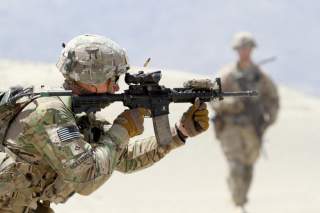Boots on the Ground: Why America Must Invest in Dominant Infantry Forces
"Our enemies today no longer fear our ships and planes. They have learned to minimize the destructiveness of our big shiny objects."
If you haven’t seen it go to Netflix and rent the movie “Top Gun.” Tom Cruise’s dog fighting skill came from a school established during Vietnam to give pilots a fighting edge against the North Vietnamese. They learned then that over 90% of all pilot losses occurred during their first four missions. The sophisticated Top Gun dog fighting simulation allowed pilots to fight their first four missions bloodlessly and many pilots’ lives have been saved since.
So why do our infantry have to learn to fight by bleeding and dying? Why don’t we give them their first four close encounters without shedding blood? We live in a world where electronic gaming is everywhere. Doctors learn surgery in simulations that don’t endanger patients, airline pilots experience dangerous situations in flight simulators, professional athletes practice play calling using simulations. How hard would it be to immerse a small infantry unit in a series of hundreds of infinitely varying combat situations where they would be able to make life or death decisions and engage and maneuver against a simulated enemy? Think how cheap an off the shelf close combat simulator would be. Think of how many lives would be saved.
For the first few decades after World War II science and technology favored the big shiny stuff. Development of precision bombing and aircraft stealth technologies gave the United States a decisive edge in the skies over Iraq and Kosovo. But times have changed. Hezbollah gave Israel an ugly surprise in 2006 when they managed to fight off the IDF using off the shelf systems such as cell phones and shoulder fired anti aircraft and anti tank missiles donated by Russia and Iran. Today micro miniaturization will allow soldiers to communicate using cell phones; the day will come when tiny drones, soldier sensors and miniaturized guided weapons will allow infantry small units to defeat much larger and heavier mechanized forces. The technology is here now.
Lenin is alleged to have once said that in war “quantity has a quality all of its own.” That sentiment certainly applies to close combat fighting. No matter how much technology is applied numbers still count and in virtually all our most recent wars we run out of infantry long before the enemy. With the exception of Desert Storm the Army and Marine Corps have had to make painful choices as a result. Infantry are hard to recruit in wartime. Too often very poor human material must be recruited into the ranks at just the time when the price for accepting bad soldiers is high casualties and immoral conduct or poor performance. In Iraq and Afghanistan the price paid for too few infantry has been psychological and physical damage that will take generations to erase.
The solution of course is to recruit more infantrymen and take the time to train and bond them together such that they become superbly prepared for the hardships of close combat. Instead of four percent the Defense Department should increase the proportion to close combat Soldiers and Marines to about six percent of active duty personnel or about 70,000 total. Infantry units should be “overmanned” by about fifty percent to account for the wastage that comes from casualties and accidents in combat.
If the past is prologue over the coming decades the nation will spend trillions for a few more knots of speed, inches of precision or bits of bandwidth. I believe to the depths of my soul that some of that money would be better spent making our close combat Soldiers and Marines better at what they alone can do: kill the enemy in close combat. Our enemies today no longer fear our ships and planes. They have learned to minimize the destructiveness of our big shiny objects. But they do fear greatly the sight of an American Soldier or Marine closing in with the intention to kill. We must, as a first priority, give these (mostly) men the tools they need to succeed and survive.
Maj. Gen. Bob Scales, USA (Ret.), is one of America’s most respected authorities on land power. He commanded two units in Vietnam and is the recipient of the Silver Star for action during the Battle of Hamburger Hill. He commanded units in Korea and the United States and completed his service as commandant of the Army War College. He’s the author of Scales on War: The Future of America’s Military at Risk published by Naval Institute Press.
Image: U.S. Army

